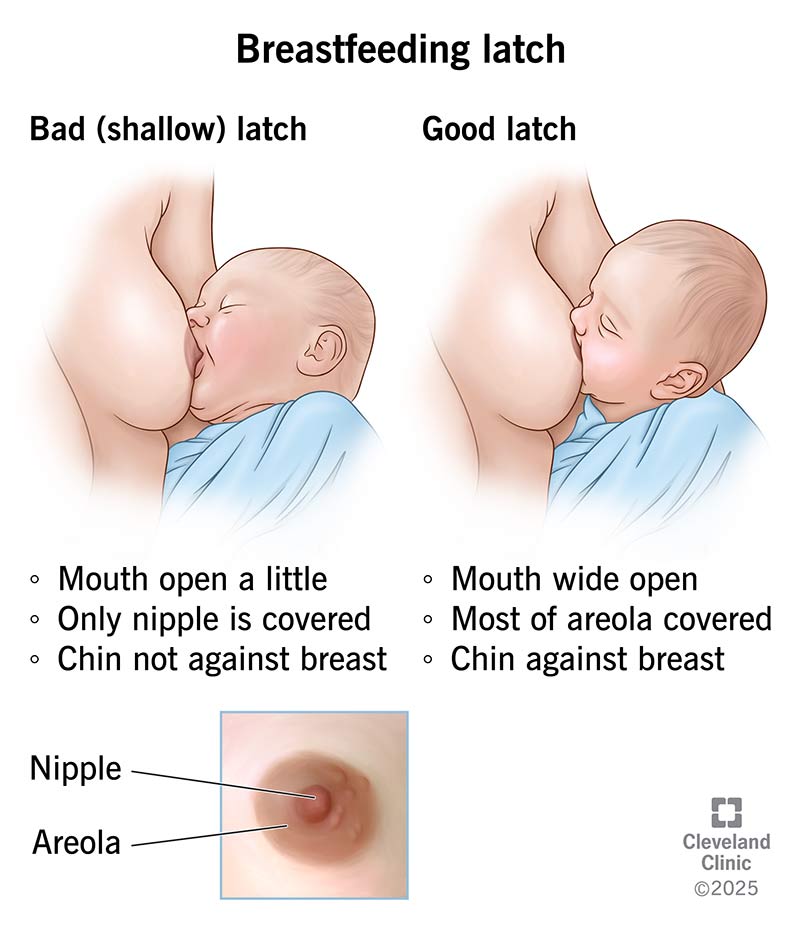A good breastfeeding latch means your baby’s mouth is wide open and covers most of the bottom part of your areola. Some of the top part of your areola should be visible above your baby’s upper lip. Their chin should rest against your lower breast. A bad, or shallow, latch means your baby is only suckling on your nipple. This causes nipple pain.
Advertisement
Cleveland Clinic is a non-profit academic medical center. Advertising on our site helps support our mission. We do not endorse non-Cleveland Clinic products or services. Policy

A breastfeeding latch is how your baby’s mouth attaches to your nipple and areola when breastfeeding. For a good latch, your baby’s mouth should cover not just your nipple, but also about 1 to 2 inches of your areola asymmetrically. This means your baby takes more of the lower part of your areola into their mouth than the top.
Advertisement
Cleveland Clinic is a non-profit academic medical center. Advertising on our site helps support our mission. We do not endorse non-Cleveland Clinic products or services. Policy
A bad latch typically means that your baby is attaching their mouth only to your nipple. This is also called a shallow latch, and it can make your nipples hurt. Your baby needs to latch onto your breast more deeply, covering your nipple plus most of your areola.
Getting a proper breastfeeding latch is important. It allows your baby to remove enough milk to support healthy weight gain. But don’t pressure yourself to have a “perfect latch.” There’s no such thing. What matters is that your baby is removing milk and you’re both comfortable.
Follow these steps to get a good latch:
Advertisement
Holding your baby and grasping your breast may require some help. This is where your partner or a loved one can step in and (literally) lend a hand. Getting a good latch takes practice. It can feel awkward at first. This is normal. But what may seem like a complex dance will get easier the more you do it.
Your baby is latched on properly for nursing if:
Your baby isn’t latched on properly if:
Your baby may have a hard time latching on to your breast if:
Clearly, lots of the things that affect latch are out of your control. So, be kind and patient with yourself and your baby. If your baby doesn’t latch on right away, it’s OK. Latch difficulties are very common, and they’re not a failure on your part.
A lactation specialist can help you identify what’s affecting your baby’s latch and how to adjust. Pumping and bottle feeding your baby is another option, and your lactation specialist can help with this, too.
In most cases, the answer is no. A nipple shield is a silicone device you wear over your nipple to help your baby latch on. It’s a temporary solution that helps in select situations.
For example, if your baby was using only bottles and never latched to your breast before, a nipple shield can help them transition to direct breastfeeding. Another example is if you have inverted nipples.
If you’re using a nipple shield, you should work closely with a lactation specialist. They’ll make a plan for you to stop using the shield as soon as possible. This is because providers have linked shield use with decreased transfer of milk and decreased supply with continued use.
If you’re having difficulties with getting your baby to latch, don’t give up. And don’t wait to reach out for help. Call a breastfeeding medicine specialist or lactation consultant if:
Advertisement
Your provider will help you work through any issues you’re facing. Breastfeeding has many benefits for you and your baby. So, don’t get discouraged if your baby isn’t latching on or nursing as easily as you’d hoped. These are common roadblocks that most people can overcome with a little extra support.
When you want so much for something to work, and it just won’t, you might feel hopeless or defeated. But getting a good latch often takes time and lots of practice. Usually, a few small adjustments to your nursing technique can make a big difference. Lactation specialists are prepared to help you each step of the way.
Advertisement
Breastfeeding is natural and rewarding, but it’s not without challenges. Get the support you need at Cleveland Clinic.

Last reviewed on 07/10/2025.
Learn more about the Health Library and our editorial process.